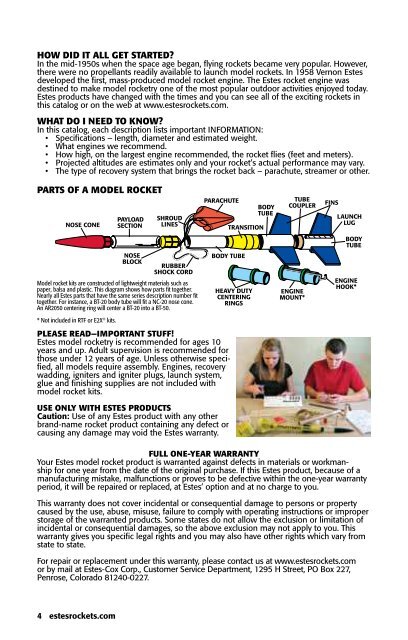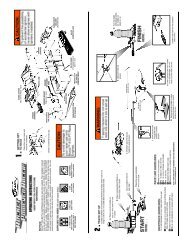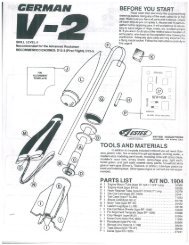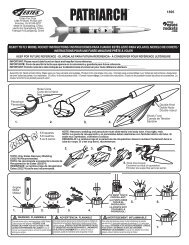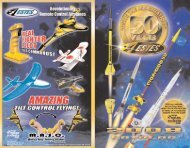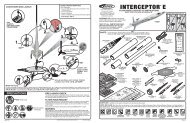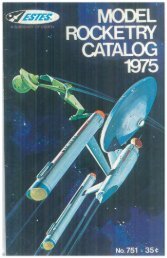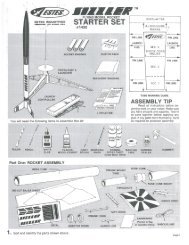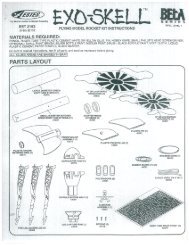Estes 2013 Catalog - AC Supply
Estes 2013 Catalog - AC Supply
Estes 2013 Catalog - AC Supply
Create successful ePaper yourself
Turn your PDF publications into a flip-book with our unique Google optimized e-Paper software.
HOW DID IT ALL GET STARTED?<br />
In the mid-1950s when the space age began, flying rockets became very popular. However,<br />
there were no propellants readily available to launch model rockets. In 1958 Vernon <strong>Estes</strong><br />
developed the first, mass-produced model rocket engine. The <strong>Estes</strong> rocket engine was<br />
destined to make model rocketry one of the most popular outdoor activities enjoyed today.<br />
<strong>Estes</strong> products have changed with the times and you can see all of the exciting rockets in<br />
this catalog or on the web at www.estesrockets.com.<br />
WHAT DO I NEED TO KNOW?<br />
In this catalog, each description lists important INFORMATION:<br />
• Specifications – length, diameter and estimated weight.<br />
• What engines we recommend.<br />
• How high, on the largest engine recommended, the rocket flies (feet and meters).<br />
• Projected altitudes are estimates only and your rocket’s actual performance may vary.<br />
• The type of recovery system that brings the rocket back – parachute, streamer or other.<br />
PARTS OF A MODEL ROCKET<br />
NOsE CONE<br />
PAYLOAD<br />
sECTION<br />
NOsE<br />
bLOCk<br />
sHROUD<br />
LINEs<br />
RUbbER<br />
sHOCk CORD<br />
Model rocket kits are constructed of lightweight materials such as<br />
paper, balsa and plastic. This diagram shows how parts fit together.<br />
Nearly all <strong>Estes</strong> parts that have the same series description number fit<br />
together. For instance, a BT-20 body tube will fit a NC-20 nose cone.<br />
An AR2050 centering ring will center a BT-20 into a BT-50.<br />
* Not included in RTF or E2X ® kits.<br />
PAR<strong>AC</strong>HUTE<br />
PLEASE READ—IMPORTANT STUFF!<br />
<strong>Estes</strong> model rocketry is recommended for ages 10<br />
years and up. Adult supervision is recommended for<br />
those under 12 years of age. Unless otherwise specified,<br />
all models require assembly. Engines, recovery<br />
wadding, igniters and igniter plugs, launch system,<br />
glue and finishing supplies are not included with<br />
model rocket kits.<br />
USE ONLY WITH ESTES PRODUCTS<br />
Caution: Use of any <strong>Estes</strong> product with any other<br />
brand-name rocket product containing any defect or<br />
causing any damage may void the <strong>Estes</strong> warranty.<br />
TRANsITION<br />
bODY TUbE<br />
HEAVY DUTY<br />
CENTERING<br />
RINGs<br />
bODY<br />
TUbE<br />
TUbE<br />
COUPLER<br />
ENGINE<br />
mOUNT*<br />
FINs<br />
LAUNCH<br />
LUG<br />
FULL ONE-YEAR WARRANTY<br />
Your <strong>Estes</strong> model rocket product is warranted against defects in materials or workmanship<br />
for one year from the date of the original purchase. If this <strong>Estes</strong> product, because of a<br />
manufacturing mistake, malfunctions or proves to be defective within the one-year warranty<br />
period, it will be repaired or replaced, at <strong>Estes</strong>’ option and at no charge to you.<br />
This warranty does not cover incidental or consequential damage to persons or property<br />
caused by the use, abuse, misuse, failure to comply with operating instructions or improper<br />
storage of the warranted products. Some states do not allow the exclusion or limitation of<br />
incidental or consequential damages, so the above exclusion may not apply to you. This<br />
warranty gives you specific legal rights and you may also have other rights which vary from<br />
state to state.<br />
For repair or replacement under this warranty, please contact us at www.estesrockets.com<br />
or by mail at <strong>Estes</strong>-Cox Corp., Customer Service Department, 1295 H Street, PO Box 227,<br />
Penrose, Colorado 81240-0227.<br />
bODY<br />
TUbE<br />
ENGINE<br />
HOOk*<br />
1. Materials. I will use only lightweight,<br />
non-metal parts for the nose, body, and fins<br />
of my rocket.<br />
2. Motors. I will use only certified,<br />
commercially-made model rocket motors,<br />
and will not tamper with these motors or<br />
use them for any purposes except those<br />
recommended by the manufacturer.<br />
3. Ignition System. I will launch my<br />
rockets with an electrical launch system and<br />
electrical motor igniters. My launch system<br />
will have a safety interlock in series with the<br />
launch switch, and will use a launch switch<br />
that returns to the “off” position when<br />
released.<br />
4. Misfires. If my rocket does not launch<br />
when I press the button of my electrical<br />
launch system, I will remove the launcher’s<br />
safety interlock or disconnect its battery,<br />
and will wait 60 seconds after the last<br />
launch attempt before allowing anyone to<br />
approach the rocket.<br />
5. Launch Safety. I will use a countdown<br />
before launch, and will ensure that<br />
everyone is paying attention and is a safe<br />
distance of at least 15 feet away when I<br />
launch rockets with D motors or smaller,<br />
and 30 feet when I launch larger rockets. If<br />
I am uncertain about the safety or stability<br />
of an untested rocket, I will check the<br />
stability before flight and will fly it only<br />
after warning spectators and clearing them<br />
away to a safe distance. When conducting<br />
a simultaneous launch of more than ten<br />
rockets I will observe a safe distance of 1.5<br />
times the maximum expected altitude of<br />
any launched rocket.<br />
6. Launcher. I will launch my rocket<br />
from a launch rod, tower, or rail that is<br />
pointed to within 30 degrees of the vertical<br />
to ensure that the rocket flies nearly<br />
straight up, and I will use a blast deflector<br />
to prevent the motor’s exhaust from hitting<br />
National Association of Rocketry<br />
MODEL ROCKET SAFETY CODE<br />
(Basic Version, Eff. August 2012)<br />
the ground. To prevent accidental eye injury,<br />
I will place launchers so that the end of the<br />
launch rod is above eye level or will cap the<br />
end of the rod when it is not in use.<br />
7. Size. My model rocket will not weigh<br />
more than 1,500 grams (53 ounces) at<br />
liftoff and will not contain more than 125<br />
grams (4.4 ounces) of propellant or 320 Nsec<br />
(71.9 pound-seconds) of total impulse.<br />
8. Flight Safety. I will not launch my<br />
rocket at targets, into clouds, or near airplanes,<br />
and will not put any flammable or<br />
explosive payload in my rocket.<br />
9. Launch Site. I will launch my rocket<br />
outdoors, in an open area at least as large<br />
as shown in the accompanying table, and in<br />
safe weather conditions with wind speeds<br />
no greater than 20 miles per hour. I will ensure<br />
that there is no dry grass close to the<br />
launch pad, and that the launch site does<br />
not present risk of grass fires.<br />
LAUNCH SITE DIMENSIONS<br />
Installed Total Equivalent Motor Minimum Site<br />
Impulse (N-sec) Type Dimensions (ft.)<br />
0.00-1.25 1/4A, 1/2A 50<br />
1.26-2.50 A 100<br />
2.51-5.00 B 200<br />
5.01-10.00 C 400<br />
10.01-20.00 D 500<br />
20.01-40.00 E 1,000<br />
40.01-80.00 F 1,000<br />
80.01-160.00 G 1,000<br />
160.01-320.00 Two Gs 1,500<br />
10. Recovery System. I will use a recovery<br />
system such as a streamer or parachute<br />
in my rocket so that it returns safely and<br />
undamaged and can be flown again, and<br />
I will use only flame-resistant or fireproof<br />
recovery system wadding in my rocket.<br />
11. Recovery Safety. I will not attempt<br />
to recover my rocket from power lines, tall<br />
trees, or other dangerous places.<br />
www.nar.org<br />
Important Note: G motors must be sold to and used by adults (18 and up) only.<br />
4 estesrockets.com 5


